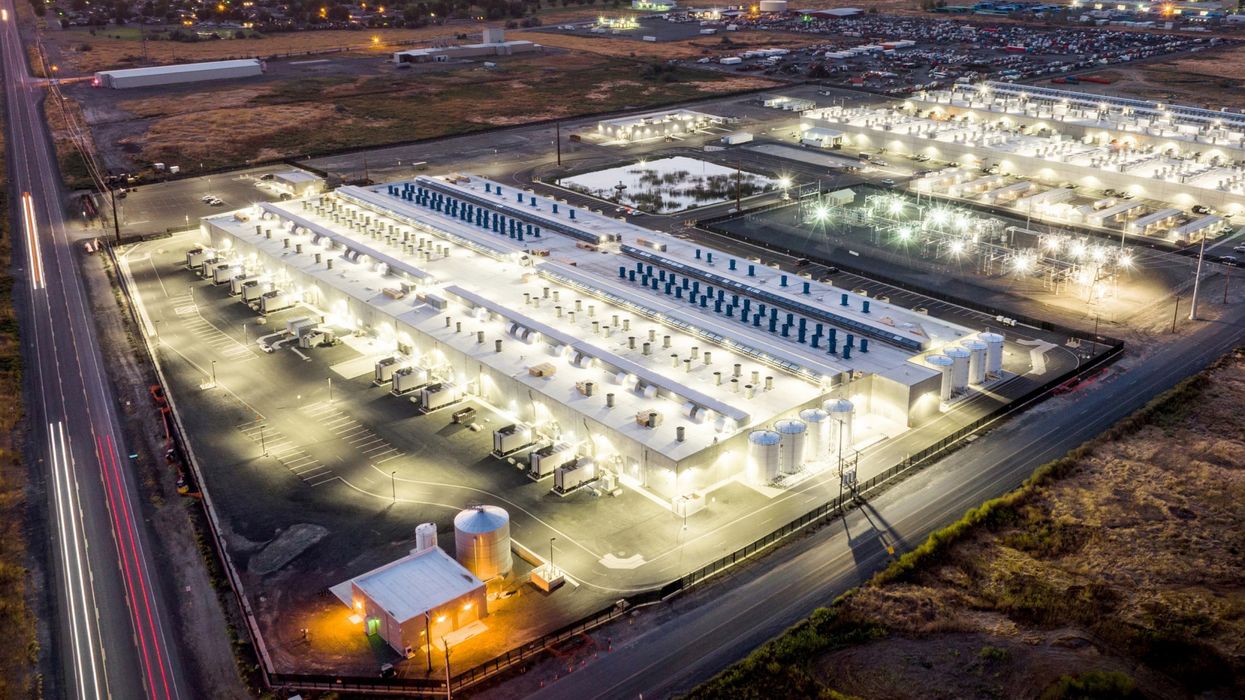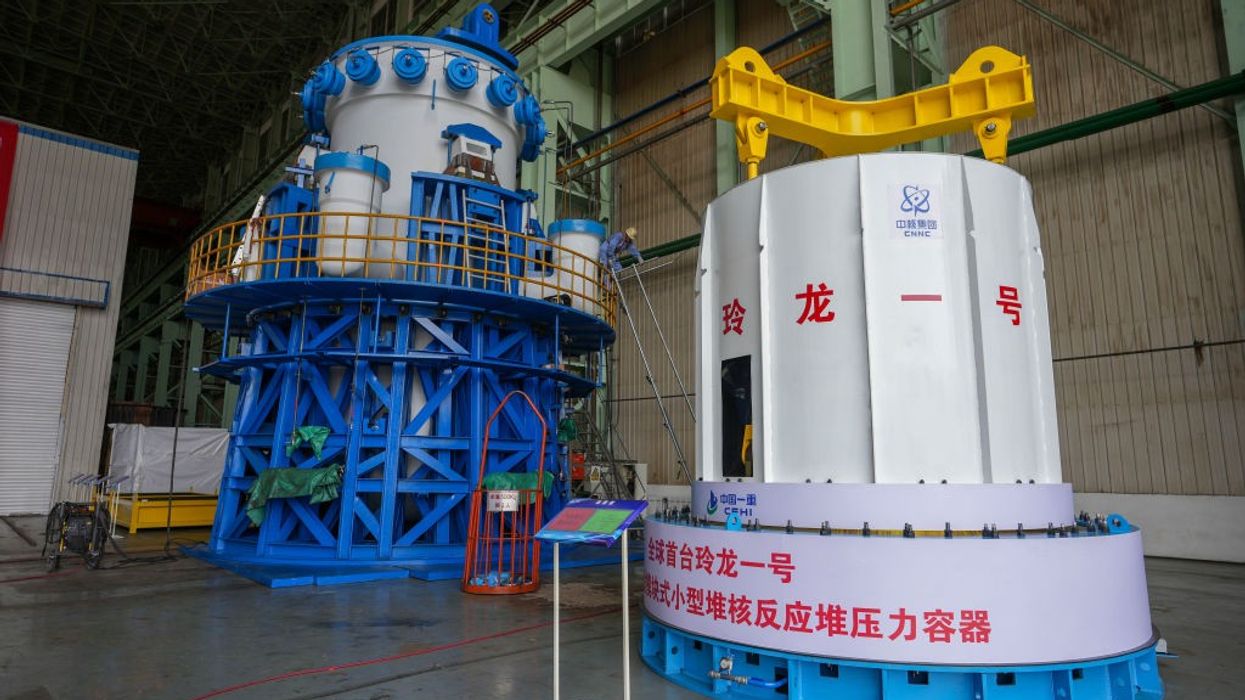Turning Down the Heat, and the Noise
With every bicycle that replaces a motorcycle, every garden hose that supplants a power-washer, every rake that displaces a leaf blower, our world will both warm a little more slowly and become a little less noisy.
The most pressing environmental crisis of these times, our heating of the Earth through carbon dioxide and other greenhouse gas pollution, is closely connected to our excessive energy consumption. And with many of the ways we use that energy, we’re also producing another less widely discussed pollutant: industrial noise. Like greenhouse-gas pollution, noise pollution is degrading our world—and it’s not just affecting our bodily and mental health but also the health of ecosystems on which we depend utterly.
Noise pollution, a longstanding menace, is often ignored. It has, however, been making headlines in recent years, thanks to the booming development of massive, boxy, windowless buildings filled with computer servers that process data and handle internet traffic. Those servers generate extreme amounts of heat, the removal of which requires powerful water-chilling equipment. That includes arrays of large fans that, in turn, generate a thunderous wall of noise. Such installations, known by the innocuous term “data centers,” are making growing numbers of people miserable.
Residents of Loudoun County, Virginia, the nation’s data-center epicenter, have filed dozens of complaints about an especially loud facility located in the town of Leesburg. People living as much as three miles from the center compared the noise from its giant cooling fans to the sounds of an airplane engine, a freight train, a huge leaf blower, or a helicopter hovering overhead, day and night.
The data center’s ear-splitting noise was so bad that it drove Mr. Zhang to seek refuge at… O’Hare Airport.
Attorneys representing a group of Williston, North Dakota, homeowners argued last December that noise pollution from the nearby Atlas Power Data Center “is a continual invasion of their homes, their health, and their North Dakota way of life. They are now virtually shut-ins in the slice of North Dakota they once called their own.” In April, Gladys Anderson of Bono, Arkansas, told reporters that a nearby cryptocurrency-mining data center was “like torture, like a form of military-grade torture.” Her neighbor complained, “It’s caused problems for me with my hearing, my blood pressure, with the sweetheart where she gets migraine headaches.”
Chicago-based airline pilot Joshua Zhang—someone who (I’m betting) knows a thing or two about loud noise—told CBS News in 2021 that a new data center in his Printers’ Row neighborhood whined like a gigantic vacuum cleaner that never shuts off. “I try to fly as much as I can to stay away from here,” he said. “I can’t really sleep well… and I have to operate a flight.” In other words, the data center’s ear-splitting noise was so bad that it drove Mr. Zhang to seek refuge at… O’Hare Airport.
Noise Makes Us Sick and We’re Sick of Noise
The recent, rapid proliferation of data centers has been due, at least in part, to the similarly rapid growth of two types of enterprises: cryptocurrency and artificial intelligence (AI). Those voracious wasters of electricity were unasked-for inventions that filled largely nonexistent human needs. And they’re amplifying the very real problem of noise pollution.
Crypto and AI illustrate a larger issue. An all-out effort to curb climate change will require deep reductions in the use of fossil fuels, which will, in turn, require more frugal use of all forms of energy. And if that happens (as it should), it will have profound repercussions throughout society. As one of the more welcome consequences, our now-cacophonous world is likely to become easier on the ears.
With every AI project abandoned, every bitcoin not mined, every pickup truck not sold, every jet fighter not flown, people somewhere will get relief. With every bicycle that replaces a motorcycle, every garden hose that supplants a power-washer, every rake that displaces a leaf blower, our world will both warm a little more slowly and become a little less noisy.
The severe impact of noise pollution on both mental and physical health is well documented. Hearing impairment is the most obvious malady it causes. The World Health Organization (WHO) finds that noise pollution severely disrupts our quality of life in other ways, too, raising the risk of heart disease, childhood cognitive impairment, sleep disturbance, and general annoyance. WHO notes that while
...annoyance is not normally classified as a health effect, it certainly affects well-being and therefore is considered to fall within the WHO definition of health as being “a state of complete physical, mental, and social well-being.” More importantly, however, it is the effect of noise that most lay people are aware of and concerned about.
And annoyance can be a gateway to much worse, to “feelings of disturbance, aggravation, dissatisfaction, concern, bother, displeasure, harassment, irritation, nuisance, vexation, exasperation, discomfort, uneasiness, distress, hate, etc.” You might think I got that quote from a thesaurus, but, no, it’s from a study published in the journal Noise and Health. Any person living near a data center or other source of loud, continuous noise can, I expect, attest to having experienced most (or all) of those feelings. And it’s well known that such stresses can lead to physiological health problems.
When it comes to making people miserable, keep in mind that not all noises are created equal. The roar from data centers, vehicle traffic, commercial lawn-care operations, and other notorious disturbers of the peace is rich in low-pitched audible frequencies that travel much further than others and can even pass through walls. Such low tones also irritate us more, even when they aren’t all that loud. Consequently, and unfortunately, people complaining about their exposure to noise from data centers or other sources of low-frequency noise are all too often dismissed as hypochondriacs. In a recent, comprehensive article on noise pollution in The Atlantic magazine, Bianca Bosker told a gripping tale of how people in Chandler, Arizona, suffered for years as their complaints about data center noise were casually dismissed by local authorities.
The Cruelty Is the Point
For those of us not living near a data center, road traffic may be the most pervasive, day-to-day source of unhealthful low-frequency noise. In the European Union, for example, 113 million people, or 20% percent of the population, live with noise pollution from road traffic that’s loud enough to raise risks of heart disease and heart failure. The risk of developing diabetes, obesity, anxiety, depression, and of course, sleep disturbance also increases as traffic noise gets louder.
Of course, we produce traffic noise collectively and most, but not all, of us hate it. In an April essay entitled “What is Noise?,” New Yorker music critic Alex Ross observed that “if you elect to hear something, it is not noise, even if most people might deem it unspeakably horrible. If you are forced to hear something, it is noise, even if most people might deem it ineffably gorgeous.” Extra-loud vehicles, particularly en masse, richly illustrate Ross’s observation.
In recent decades, American pickup trucks and SUVs have grown steadily larger and heavier, with towering front ends and armoring that create a road-ruling mystique. Increasingly, to further satisfy consumer demand for big, intimidating vehicles, automakers equip many of them with high-decibel engines, turbochargers, and thunderous exhaust systems. Drivers all too regularly dial the volume up several more notches with muffler modifications that are often illegal. The automakers’ economic motivation for offering big, loud vehicles is clear ($), but why exactly do their customers want them? The deafening din emanating from those trucks has distinct political undertones, but there may also be something deeper going on.
A 2023 study published in the journal Current Issues in Personality Psychology sheds some light on this. The researcher interviewed 529 people, split almost equally between the sexes, about their attitudes toward noisy vehicles. Then, using questionnaires, she evaluated the subjects for four “dark” personality traits: Machiavellianism, narcissism, psychopathy, and sadism. It turned out (surprise!) that men liked loud vehicles significantly more than women did. Across both sexes, those who expressed greater fondness for such vehicles also tended to score higher for two dark personality traits: psychopathy and sadism. The researcher drily observed that the results made perfect sense:
Psychopathy reflects an up-close cruelty, whereas sadism includes viewing the harm to others from a distance… Modifying a muffler to make a car louder is disturbing to pedestrians, other drivers, and animals at a distance, meeting the sadism component, as well as startling when [the victim is] up close at intersections, meeting the psychopathy component.
The author of that study is not a medical professional (nor am I); still, it’s not exactly illogical to consider guys who alter their trucks to produce brain-rattling noise psychopaths. I’m not a lawyer either, but it still seems to me that labeling such practices a form of reckless indifference to human well-being is anything but unreasonable.
Quietness Should Be a Right, Not a Privilege
For decades, the environmental justice movement has been fighting a longstanding American tradition of locating dirty, dangerous industries and activities in low-income, racialized communities. This is a problem that arises with every environmental issue, and noise is no exception. Alex Ross recognized that in his “What Is Noise?” essay when he observed, “Silence is a luxury of the rich… For the rest of society, noise is an index of struggle.”
In neighborhoods with lower socioeconomic status and/or large Indigenous, Asian, Black, or Latino populations, residents endure greater exposure to noise pollution, especially in areas where informal racial segregation is more severe. Not surprisingly, a separate study found that the same demographic groups experience highly disproportionate levels of annoyance from noise caused by road traffic or aircraft.
Consider it a certain irony then that, despite being exposed to less noise pollution, white Americans are subject to significantly higher rates of hearing loss than Black Americans—and it’s unclear why. Andrew Van Dam of The Washington Post complicated matters further when he noted that there’s also a political disparity: The higher the share of Republicans in a state or county, the greater the rate of hearing loss. He couldn’t fully explain this as a result of populations in redder states being generally whiter and older. There had to be some other factor. When Van Dam looked further, he found one that made a big difference in the prevalence of hearing loss: Politically redder areas have higher rates of recreational firearm ownership than bluer areas, with lots more hunting and gun-range target practice—another kind of noise pollution entirely.
No Peace, No Quiet
The U.S. military also has lots of guns, as well as an enormous climate footprint. A dramatic downsizing of our war-making capacity (and the staggering Pentagon budgets that go with it)—badly needed for both humanitarian and ecological reasons—would have the salutary side-effect of shrinking one of our major sources of noise pollution and hearing loss.
It should come as no surprise that researchers in a wide range of countries have found that hearing loss is more common among military personnel than in the general population. Among American service members, almost 15% suffer hearing impairment. Hearing loss is one of the most common health problems of veterans, especially those who served in special forces units (where it’s twice as prevalent as elsewhere in the armed forces). The exposure of those in such units to large-caliber weapon fire, urban combat training, and the like clearly has a lot to do with that.
In military operations, jet aircraft are the most intense source of both greenhouse-gas emissions and noise pollution. Jets account for almost 80% of the military’s fuel consumption. Their noise output is not as precisely quantified, but recent research in a study on civilian impacts around Naval Air Station Whidbey Island in Washington State found that, in the county where the base is located, two-thirds of the resident population were exposed to noise levels that could have negative health effects. One-fifth suffered high levels of annoyance and 9% were “highly sleep disturbed.” Worse yet, according to that study, “the Swinomish Indian Tribal Community of the Swinomish Reservation [located northeast of the airfield] was extremely vulnerable to health risks, with nearly 85% of residents being exposed.”
In Salina, Kansas, where Priti Gulati Cox and I live, we have less frequent but highly immersive experiences with military noise pollution every time the curiously named “Jaded Thunder joint exercise” comes to town. In part of that “exercise,” pilots from the Air Force, Army, Marines, and Navy take off from a nearby airfield in fighter jets and fly low over our city of 50,000. The noise hits you suddenly, like a roundhouse punch. It’s like nothing I’ve heard or felt elsewhere. My own reaction to such overwhelming noise levels is similar to those found in survey responses from several residents of Madison, Wisconsin, who hear fighter jet noise much more routinely than we Salinans do. As one of them put it: “Everything I’m doing comes to a halt… my entire body tenses up and my heart starts racing… utterly jarring… impossible to make out dialogue… impossible to just continue any activity… reminds me of every innocent soul killed in a bombing by my home country.” Finally, there was simply this: “Annoyed.”
Cooler Means Quieter
America was getting louder before the rise of data centers, but now it’s getting louder faster. Unfortunately, the research on that is sparse, but it’s still a reasonable conclusion to draw. In her article, Bianca Bosker pointed out another intriguing indicator of our rising noise problem. Fire-engine sirens today are designed to be more than twice as loud as those of the 1970s, just so they’ll be audible above the rising din of our cities and suburbs. And keep in mind that they’re eight times as loud as the sirens of 1912.
Climate mitigation is also noise mitigation. To avoid baking the Earth, governments must quickly phase out the use of oil, gas, and coal. With a slimmed-down energy supply, economies will need to direct fuels and electricity toward uses that meet more essential needs. Crypto and AI are not among such uses, nor can we afford to keep streets and highways crammed with gas- and diesel-guzzling private vehicles. For those and many other reasons, count on one thing: Strong efforts to reduce greenhouse gas emissions will also have striking beneficial side effects, including more peace and quiet. And that should be music to our ears.


